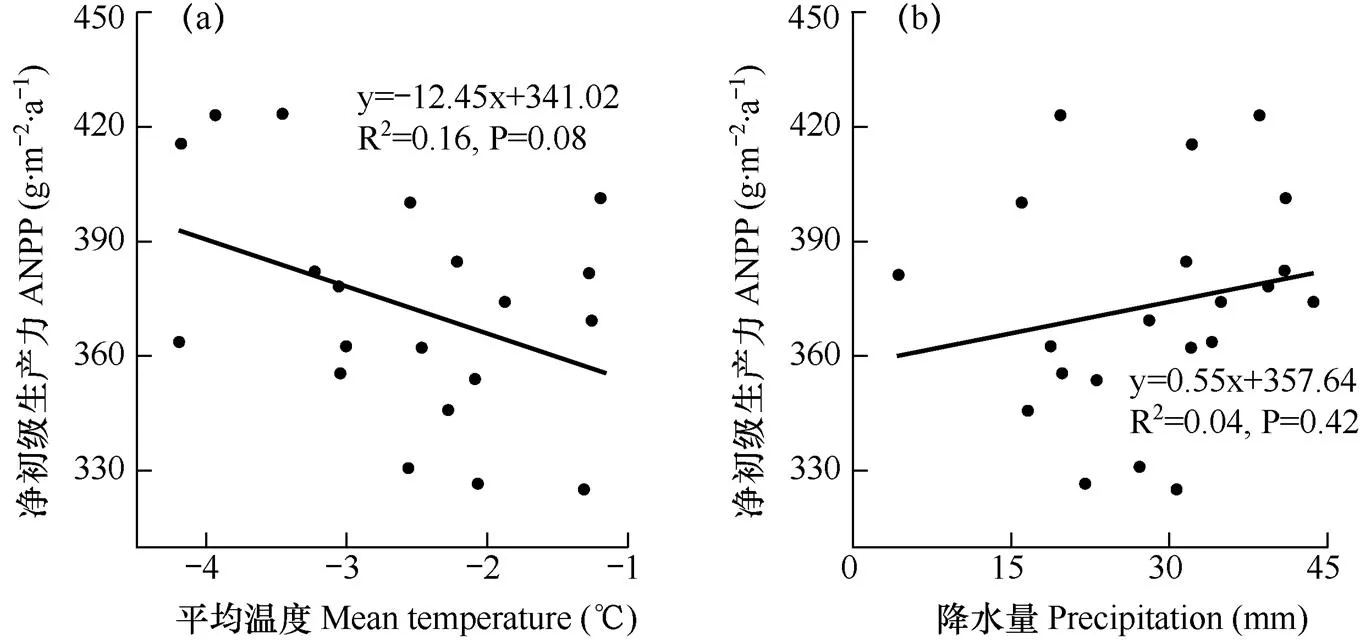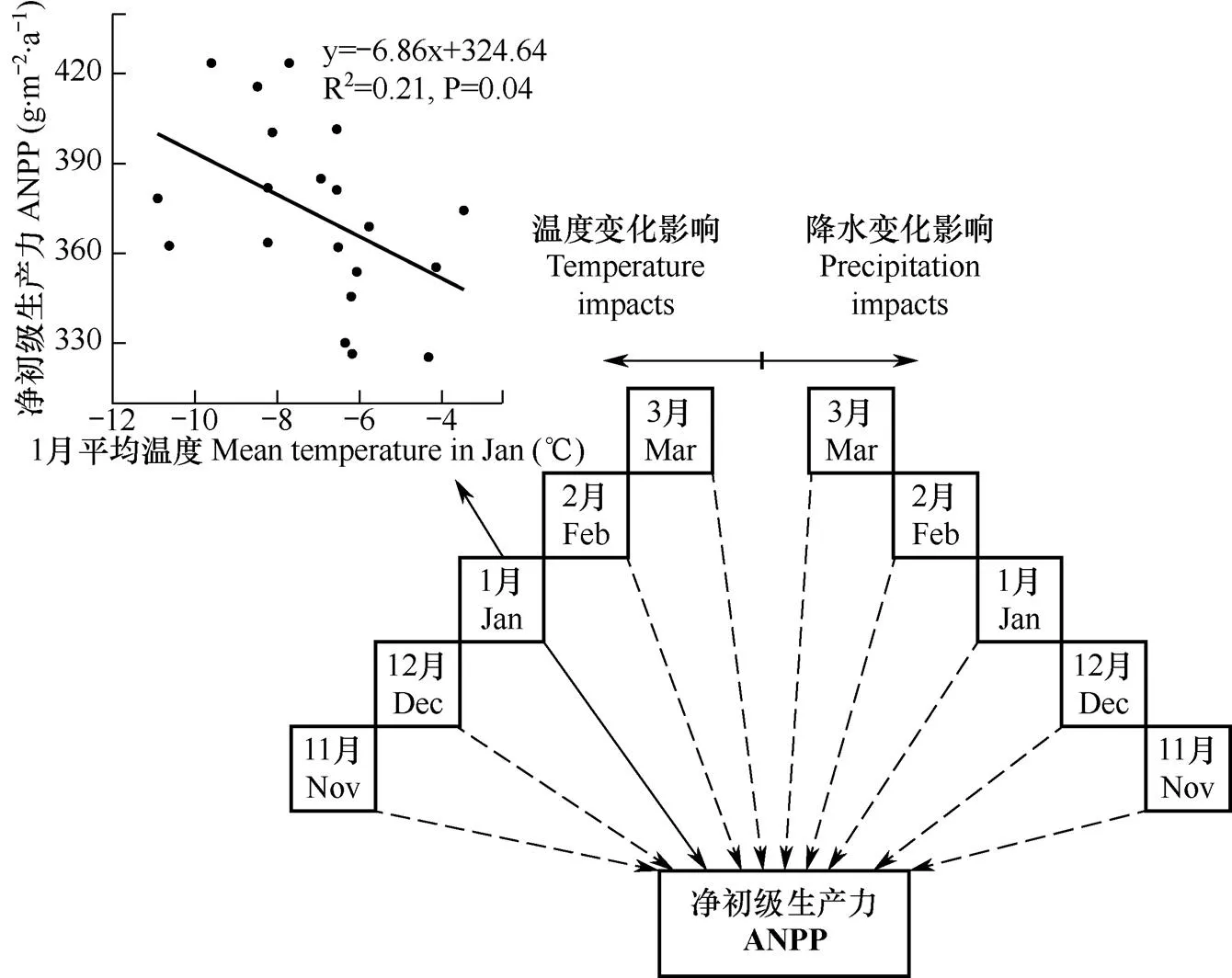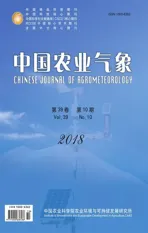宁夏云雾山典型草原休眠期气候变化对生产力的影响*
2018-10-18郑周敏罗瑞敏程积民
郑周敏,罗瑞敏,程积民,,郭 梁
宁夏云雾山典型草原休眠期气候变化对生产力的影响*
郑周敏1,罗瑞敏1,程积民1,2,3**,郭 梁2,3**
(1.西北农林科技大学动物科技学院,杨凌 712100;2.西北农林科技大学水土保持研究所,杨凌 712100;3.中国科学院水利部水土保持研究所黄土高原土壤侵蚀与旱地农业国家重点实验室,杨凌 712100)
基于1992−2011年黄土高原典型草原长期生产力观测数据及相应气候资料,分析了近20a来宁夏云雾山地区休眠期(11月−翌年3月)温度及降水变化趋势,利用简单线性回归及偏最小二乘回归法(Partial Least Squares regression-PLS)探究了休眠期月和日不同尺度温度和降水变化对草地生产力的影响特征,以揭示黄土高原典型草原生产力对休眠期气候变化的响应规律。结果表明:(1)近20a来研究区休眠期平均气温以0.09℃·a−1的速率极显著升高(P<0.01),其中1月和3月升温最为显著(P<0.01);(2)休眠期降水量较少,且年际间变异较大,各月降水变化趋势亦不显著;(3)休眠期内不同阶段温度变化对草地生产力具有不同影响,但整体呈现抑制效应,降水变化对生产力影响不显著;(4)休眠期温度升高抑制草地生产力发展,其作用机制可能与温度升高引起的地表积雪减少、冻融交替频繁及土壤微环境变化有关。休眠期降雨较少,降雨与草地生产力并不存在显著作用关系。降雪作为降水的固态形式,其对生产力的影响特点及作用机制尚待深入探究。
黄土高原;草地生产力;休眠期;气候变化;水热条件
草地是陆地生态系统的重要组成部分,约占全球陆地面积的30%,主要分布于干旱半干旱地区[1]。地上净初级生产力(aboveground net primary production-ANPP)是草地生态系统最为重要的生态指标之一,决定着草地生态系统的基本功能[2]。与其它生态系统相比,草地生产力具有较高的时间变异性及气候变化敏感性[3−4]。气候驱动的草地生产力的变化对全球碳平衡、生态系统物质循环与能量流动、畜牧业发展以及草地资源的持续性利用均具有重要影响[4−6]。因此,生产力年际变化规律及其与全球气候变化的相关性已成为生态学研究的热点。
目前有关气候变化对生产力影响的研究多从年降水和年平均温度变化角度加以分析[7−8]。植被生长发育对不同季节的气候变化响应存在差异性,与年尺度气候变化影响相比,不同季节水热条件的变化是ANPP更有效的驱动力[9−11]。此外,全球气候变化背景下,降水分配及增温幅度存在显著的季节差异性[12],进一步表明分季节进行气候变化效应研究具有重要科学意义。相对大量的生长季气候变化影响研究,休眠期作为植被躲避恶劣环境,维持翌年生存生长的关键期却较少受到关注。虽有报道指出,休眠期气候变化对草地生产力的影响较低[13],然而持续增强的全球变暖趋势,特别是冬季显著增温,其对生产力的影响力将逐渐增强。因此,近年来休眠期气候变化对草地生产力的影响越来越受到研究者的重视[14−15]。
休眠期降雨较少,降雪为冬季主要降水方式。在季节性的雪被覆盖区,积雪的覆盖和融化交替,不仅直接影响土壤水分、土壤温度、光照条件以及养分状况,而且还影响土壤动物、微生物和地面食草动物和昆虫的活动节律,直接或间接对植被群落生产力产生深刻影响。虽然人类早就认识到“瑞雪兆丰年”这样的自然现象,但真正从科学角度进行系统研究,目前还处于起步阶段。研究表明,积雪变化对草本植物的生长和生产力具有显著影响[16]。有分析指出,随着雪被厚度增加,积雪可以显著提高不同品种紫花苜蓿的越冬成活率和生产力[17]。但也有报道认为,积雪深度的增加和积雪持续时间的延长对下一年植被生长具有不利影响[18]。因此,系统性研究休眠期降雪变化特征及其对草地生产力影响机制亟待加强。
休眠期增温对植被生产力的影响,不同研究结果间也存在一定分歧。有研究指出,冬季增温可提高草地生产力[19],特别是在高纬度高寒地区,休眠期增温对草地生产力的促进作用更明显[20]。Natali等[19]在苔原植被研究中发现,冬季增温使土壤温度增加了2.3℃,植物生产力提高了20%。此外,冬季增温可使植物返青期提前[21],延长植物光合作用阶段,有利于生产力提高。但李镇清等[22]根据中国科学院内蒙古草原生态系统定位研究站近20a的观测资料指出,显著的冬季升温使该地区春季干旱加剧,进一步降低了草原生产力水平。Grime等[4]冬季增温试验发现,冬季升温显著降低了草地生产力。另外,冬季温度升高加速积雪融化使积雪深度减小,导致植被频繁暴露于冻融交替中。Grimm等[23]指出,冬季积雪深度降低使地表易受冻害,对植物生长不利。2007年12月斯堪的纳维亚北部地区极端升温,积雪覆盖减少导致当地植物大面积死亡[24]。
研究休眠期气候变化对草地的影响有利于认识冬季在全年生态系统功能中的潜在作用。IPCC第五次报告指出,全球气候变化将对生态系统初级生产力产生巨大影响,特别是在生态环境脆弱的地区[12]。黄土高原大部分地区处于干旱半干旱区,降水较少,对气候变暖的响应极为敏感[25]。本研究分析了近20a来黄土高原典型草原生产力的年际变化,并结合休眠期气象资料,探究草地生产力对休眠期气候变化的响应特征,以期为草地生产力对气候变化响应的深入研究,黄土区植被恢复与重建提供参考依据。
1 材料与方法
1.1 研究区概况
研究区为宁夏回族自治区固原市的云雾山国家级自然保护区(36°10′−36°17′N,106°21′−106°27′E,1800−2100m)。地处黄土高原西南部,属于典型的温带半干旱气候。年平均温度7℃,年平均降水量425mm,降水主要集中于6−8月,占全年降水量的57%。冬季降雨较少,降雪为冬季主要降水形式。11月初开始降雪,2月底3月初积雪深度达到最大,随后迅速下降,4月初基本完全融化,植被休眠期内(11月−翌年3月)平均积雪深度为1.2cm。目前研究区物种数为313种,优势物种包括长芒草()、大针茅()、甘青针茅()、百里香()、白莲蒿()以及星毛委陵菜()等[26]。
1.2 数据采集
草地地上部分最大生物量包括植物活体及立枯体两部分,通常用于估算草地地上净初级生产力[27]。长期定位监测表明,研究区8月中旬植被地上部生物量最高。因此,1992−2011年,于每年8月15日左右采用齐地面刈割法进行地上生物量收集。保护区内设置了300m×100m的采样带(地势相对平整、物种组成一致),每年在采样带中随机进行草地最大生物量采集,样方面积为1m×1m,重复15次。收获的地上生物量在65℃鼓风干燥箱中烘干至恒重。同期每日温度和降水量数据来自研究区内小型气象观测站。
1.3 统计分析方法
利用简单线性回归分析近20a研究区休眠期温度和降水变化趋势,采用Mann-Kendall方法进行趋势检验[28],同时也用简单线性回归分析休眠期温度和降水变化与草地生产力的相关性,并用单因素方差分析(ANOVA)方法进行检验。
利用偏最小二乘回归法(Partial Least Squares regression-PLS)分析草地生产力对1992−2011年休眠期内每日温度及降水变化的响应规律。偏最小二乘回归法集多元线性回归、典型相关分析及主成分分析功能于一体,适用于单因素变量对多自变量的回归建模,这与本研究数据类型吻合,此方法在日尺度气候变化效应分析中具有较高的应用价值[29]。PLS分析主要产生两个输出指标,分别是变量重要性值(Variable Importance in the Projection -VIP)及标准化模型系数(Standardized Model Coefficients)。前者反映了自变量在解释因变量变化时的重要性,通常设定0.8为衡量自变量重要性与否的标准;标准化模型系数则反映自变量与因变量相关性的强弱与方向。正的模型系数表示温度升高或降水增多对草地生产力有促进作用;负的模型系数则表示气候因子与草地生产力存在负相关。
统计分析及图形绘制在R3.2.0中进行,PLS分析主要依赖R统计分析软件中的“pls”包[30]。
2 结果与分析
2.1 休眠期平均气温和降水变化趋势及其对草地生产力的影响
由图1a可见,1992−2011年休眠期(11月−翌年3月)平均气温在−4.2~−1.2℃,其中1996年最低,2007年最高,整个分析期内气温呈极显著升高的趋势,平均升温速率为0.09℃·a−1(P<0.01)。研究期内降水量变化趋势见图1b,由图可见,历年休眠期降水量很小,在4.4~43.6mm,且年际间差异较大,降水最少的年份是1999年,最大的是2010年,多数年份休眠期降水在20~40mm,近20a降水无明显的线性变化趋势。每年8月中旬对研究区内样方植物地上生物量进行收集,以其单位面积最大干物质质量作为草地地上净初级生产力。由图1c可见,1992−2011年草地生产力呈显著下降趋势,平均下降速率为2.39g·m−2·a−1(P<0.05)。进一步分析休眠期平均气温、降水量与草地生产力之间的关系(图2),但未见显著相关性。
2.2 休眠期内每月平均气温和降水量变化趋势及其对草地生产力的影响
由图3a可见,1992−2011年休眠期各月平均气温经历了先降低后升高的过程。1月气温最低(−7℃),3月最高(2.3℃)。休眠期各月降水量均较低,且年际间变异较大,降水量最大的3月也仅有9.9mm(图3b)。对休眠期各月平均气温变化趋势进行分析可知,1月和3月气温的升高极显著(P<0.01),如1月份平均气温每年升高0.17℃,20a来升高了3.4℃。其它月份气温虽有所上升,但未达显著水平(图3c)。与显著升温相比,近20a来休眠期各月降水未出现明显变化趋势,11月降水增加幅度比其它月份稍大,但并不显著(图3d)。

图1 1992−2011年云雾山休眠期内(11月−翌年3月)平均气温、降水量及草地生产力的年际变化
注:净初级生产力指单位面积最大干物质质量。图1c中短线指示每年生产力调查时样方间生产力的标准差。下同。
Note: ANPP refers to dry matter maximum mass per unit area. The short lines in Fig. 1c indicate the standard deviation of productivity data across different sampling areas for each year. The same as below.

图2 1992−2011年云雾山休眠期(11月−翌年3月)内平均气温、降水量与草地生产力的相关关系
进一步分析每月平均气温和降水量与草地生产力的关系发现(图4),1992−2011年仅1月份平均气温与生产力达到显著负相关水平(P<0.05),各月降水量与生产力亦无显著相关。
2.3 休眠期每日气温和降水量变化对草地生产力的影响
依据偏最小二乘回归产生的2个指标(变量重要性值VIP和标准化模型系数),对休眠期每日温度和降水的影响效应进行分析。由图5a可以看出,休眠期不同阶段温度变化对生产力的影响存在一定的差异性,表现为有些阶段影响显著(VIP>0.8),有些阶段作用微弱。进一步结合图5c中模型系数这一指标可以发现,显著影响阶段内,温度变化对生产力的作用仍存在差异,表现为虽整体呈现负相关,即休眠期温度升高抑制草地生产力,但也包含部分正相关,特别是在12月份。休眠期内每日温度影响效应的差异性,较好地解释了上述分析中月尺度以及整个休眠期平均温度与生产力的弱相关。由图5b和图5d可以看出,休眠期内不同阶段降水的作用效应并不相同,正负影响相抵,无明显整体影响趋势;此外,休眠期内降水较少(图5f),因此,研究区休眠期降水量与生产力并不存在显著相关关系。

图3 1992−2011年云雾山草地休眠期各月气温和降水均值(a-b)及其变化趋势(c-d)
注:*和**分别表示通过0.05和0.01水平的显著性检验。下同。
Note:*and**indicate significance test at 0.05 and 0.01 levels, respectively. The same as below.

图4 1992−2011年云雾山休眠期每月气温、降水量与草地生产力的相关分析
注:实线代表显著相关,虚线表示相关性不显著。
Note: The solid lines indicate significant relationships exist, while the dashed lines imply weak correlations.

图5 1992−2011年草地生产力与休眠期每日气温及降水量的PLS分析结果
注:图a、图b中蓝色标记部分表示变量重要性值(VIP)大于阈值0.8,代表所对应阶段中温度或降水变化对草地生产力有显著影响;图c和图d的红色标示部分表示模型系数为负,代表气候变化与草地生产力间为负相关关系,绿色表示模型系数为正,代表温度升高或降水增加对生产力有正效应,灰色表示气候因子变化与生产力无明显相关;图e和图f中黑色曲线表示休眠期每日平均气温及降水量,灰色部分代表每日温度或降水变化的标准偏差。
Note: Blue bars in the Fig. 5a&b indicate that VIP values are greater than 0.8, the threshold for variable importance, and important relationships between grassland productivity and climate variation during these periods. Red color in the Fig. 5c&d mean that model coefficients are negative and important, while green color indicates important positive relationships between grassland productivity and climate variables. The black lines in the Fig. 5e&f stand for daily mean temperature and precipitation, while grey area represents the standard deviation of daily climate variables.
3 结论与讨论
采用偏最小二乘回归方法提高了在高精度水平上分析气候变化对草地生产力影响规律的能力。休眠期内不同阶段温度变化对草地生产力具有不同影响,虽整体呈现负相关,但存在正负效应相互抵消的现象。此结果可很好地解释研究中月尺度及休眠期平均温度与草地生产力之间的弱相关性。休眠期内温度对生产力影响的间断性,目前尚缺乏相应的生理及分子机制验证,但类似的结论Benmoussa等近期已有报道[31−32]。
本研究结果表明,休眠期温度升高对草地生产力有一定的抑制作用,这与中纬度温带地区类似研究结果相同[33]。在黄土高原半干旱区,春季融雪是返青期植物生长所需水分的重要来源,冬季温度升高,降雪及积雪减少,不仅增强了冬季冻融交替的频率[4],还会导致翌年春天水分供应不足,限制春季植被生长。此外,休眠期温度升高,根系及微生物冬季新陈代谢增强,土壤水分养分消耗增加[34],导致生长季初期供植物利用的养分水分不足,也会造成生产力的下降。休眠期增温还可能通过推迟草地低温需求满足的时间,延迟春季返青物候而抑制生产力[14]。但就目前而言,研究区春季物候未出现明显推迟迹象。这主要是因为近20a来研究区休眠期内平均温度为−2.6℃,植物冷需求量很容易得到满足。但值得注意的是,研究区冬季(11月−翌年3月)增温显著高于其它季节[34],这也与IPCC第五次报告指出的冬季增温显著高于其它季节[12]一致。未来持续性、高强度冬季增温是否会延迟春季物候,进而降低草地生产力,值得深入研究。
降雪作为休眠期主要降水形式,对草地生产力具有重要影响[16]。但就目前常规气象观测而言,积雪显然不如温度、降水观测普遍。研究区每日降雪数据的缺失,限制了从机制层面阐述降雪变化对生产力的影响规律。因此,未来应加强对冬季降雪的日尺度观测。全球气候变暖下,休眠期降雪量及积雪深度下降已成不争事实[35],其对草地生产力及陆地生态系统的影响研究亟待加强。
[1] Shi Y,Wang Y,Ma Y,et al.Field-based observations of regional-scale,temporal variation in net primary production in Tibetan alpine grasslands[J].Biogeosciences,2014,11(7):2003-2016.
[2] Mao D,Wang Z,Li L,et al.Spatiotemporal dynamics of grassland aboveground net primary productivity and its association with climatic pattern and changes in Northern China[J].Ecological Indicators,2014,41:40-48.
[3] Knapp A K,Smith M D.Variation among biomes in temporal dynamics of aboveground primary production[J].Science,2001,291(5503):481-484.
[4] Grime J P,Brown V K,Thompson K,et al.The response of two contrasting limestone grasslands to simulated climate change[J].Science,2000,289(5480):762-765.
[5] Guo Q,Hu Z,Li S,et al.Spatial variations in aboveground net primary productivity along a climate gradient in Eurasian temperate grassland: effects of mean annual precipitation and its seasonal distribution[J].Global Change Biology,2012,18(12):3624-3631.
[6] Sala O E,Gherardi L A,Reichmann L,et al.Legacies of precipitation fluctuations on primary production:theory and data synthesis[J].Philosophical Transactions of the Royal Society B-Biological Sciences,2012,367(1606):3135-3144.
[7] Hu Z,Fan J,Zhong H,et al.Spatiotemporal dynamics of aboveground primary productivity along a precipitation gradient in Chinese temperate grassland[J].Science in China Series D-Earth Sciences,2007,50(5):754-764.
[8] Zhang B,Cao J,Bai Y,et al.Effects of rainfall amount and frequency on vegetation growth in a Tibetan alpine meadow[J].Climatic Change,2013,118(2):197-212.
[9] Craine J M,Nippert J B,Elmore A J,et al.Timing of climate variability and grassland productivity[J].Proceedings of the National Academy of Sciences of the United States of America,2012,109(9):3401-3405.
[10] Chou W W,Silver W L,Jackson R D,et al.The sensitivity of annual grassland carbon cycling to the quantity and timing of rainfall[J].Global Change Biology,2008,14(6):1382-1394.
[11] Robinson T M P,La Pierre K J,Vadeboncoeur M A,et al.Seasonal,not annual precipitation drives community productivity across ecosystems[J].Oikos,2013,122(5):727-738.
[12] IPCC.Climate change 2013:the physical science basis:working group I contribution to the fifth assessment report of the intergovernmental panel on climate[M].Cambridge :Cambridge University Press,2014:1552.
[13] La Pierre K J,Yuan S,Chang C C,et al.Explaining temporal variation in above-ground productivity in a mesic grassland:the role of climate and flowering[J].Journal of Ecology,2011,99(5):1250-1262.
[14] Yu H,Luedeling E,Xu J.Winter and spring warming result in delayed spring phenology on the Tibetan Plateau[J].Proceedings of the National Academy of Sciences of the United States of America,2010,107(51):22151-22156.
[15] Ladwig L M,Ratajczak Z R,Ocheltree T W,et al.Beyond arctic and alpine: the influence of winter climate on temperate ecosystems[J].Ecology,2016,97(2):372-382.
[16] 范连连,马健,吴林峰,等.古尔班通古特沙漠南缘草本层对积雪变化的响应[J].植物生态学报,2012,36(2):126-135.
Fan L L,Ma J,Wu L F,et al.Response of the herbaceous layer to snow variability at the south margin of the gurbantong-gut desert of china[J].Chinese Journal of Plant Ecology,2012,36(2):126-135.(in Chinese)
[17] 岳亚飞,王旭哲,张凡凡,等.覆雪厚度对不同苜蓿品种越冬率及产草量的影响[J].中国草地学报,2016,38(3):71-77.
Yue Y F,Wang X Z,Zhang F F,et al.Effect of snow depth on yield and winter surviving rate of different alfalfa varieties[J].Chinese Journal of Grassland,2016,38(3):71-77.(in Chinese)
[18] Wan Y,Gao Q,Li Y,et al.Change of snow cover and its impact on alpine vegetation in the source regions of large rivers on the Qinghai-Tibetan Plateau, China[J]. Arctic Antarctic and Alpine Research,2014,46(3):632-644.
[19] Natali S M,Schuur E A G,Rubin R L.Increased plant productivity in Alaskan tundra as a result of experimental warming of soil and permafrost[J].Journal of Ecology,2012,100(2):488-498.
[20] Kreyling J,Beierkuhnlein C,Jentsch A.Effects of soil freeze-thaw cycles differ between experimental plant communities[J].Basic And Applied Ecology,2010,11(1):65-75.
[21] Hudson J M G,Henry G H R.Increased plant biomass in a High Arctic heath community from 1981 to 2008[J].Ecology,2009,90(10):2657-2663.
[22] 李镇清,刘振国,陈佐忠,等.中国典型草原区气候变化及其对生产力的影响[J].草业学报,2003,12(1): 4-10.
Li Z Q,Liu Z G,Chen Z Z,et al.The effects of climate changes on the productivity in the Inner Mongolia steppe of China[J].Acta Prataculturae Sinica,2003,12(1): 4-10.(in Chinese)
[23] Grimm N B,Chapin F S I,Bierwagen B,et al.The impacts of climate change on ecosystem structure and function[J].Frontiers in Ecology and the Environment,2013,11(9):474-482.
[24] Bokhorst S F,Bjerke J W,Tommervik H,et al.Winter warming events damage sub-Arctic vegetation:consistent evidence from an experimental manipulation and a natural event[J].Journal of Ecology,2009,97(6):1408-1415.
[25] 雷俊,姚玉璧,孙润,等.黄土高原半干旱区物候变化特征及其对气候变暖的响应[J].中国农业气象,2017,38(1):1-8.
Lei J,Yao Y B,Sun R,et al.Phenological variation and its response to climate warming in semi-arid region of Loess Plateau[J].Chinese Journal of Agrometeorology,2017,38(1):1-8.(in Chinese)
[26] 程积民.黄土高原草原生态系统研究-云雾山国家级自然保护区[M].北京:科学出版社,2014.
Cheng J M.Grassland ecosystem of the Loess Plateau in China-Yunwushan National Nature Reserve[M].Beijing:Science Press,2014. (in Chinese)
[27] Scurlock J,Johnson K,Olson R J.Estimating net primary productivity from grassland biomass dynamics measurements[J].Global Change Biology,2002,8(8):736-753.
[28] Tao F,Yokozawa M,Xu Y,et al.Climate changes and trends in phenology and yields of field crops in China,1981-2000[J].Agricultural and Forest Meteorology,2006,138(1-4):82-92.
[29] Guo L,Dai J,Wang M,et al.Responses of spring phenology in temperate zone trees to climate warming:a case study of apricot flowering in China[J].Agricultural and Forest Meteorology,2015,201:1-7.
[30] Mevik B,Wehrens R,Liland K.PLS:partial least squares and principal component regression[CP/OL].http://CRAN.R-project.org/package=pls,2016-12-28.
[31] Benmoussa H,Ghrab M,Ben Mimoun M,et al.Chilling and heat requirements for local and foreign almond(Mill.) cultivars in a warm Mediterranean location based on 30 years of phenology records[J].Agricultural and Forest Meteorology,2017,239:34-46.
[32] Guo L,Chen J,Luedeling E,et al.Early-spring soil warming partially offsets the enhancement of alpine grassland aboveground productivity induced by warmer growing seasons on the Qinghai-Tibetan Plateau[J].Plant and Soil,2018,425(1-2):177-188.
[33] Schuerings J,Jentsch A,Walter J,et al.Winter warming pulses differently affect plant performance in temperate heathland and grassland communities[J].Ecological Research,2014,29(4):561-570.
[34] Guo L,Cheng J,Luedeling E,et al.Critical climate periods for grassland productivity on China’s Loess Plateau[J].Agricultural and Forest Meteorology,2017,233:101-109.
[35] Sánchez-Bayo F,Green K.Australian snowpack disappearing under the influence of global warming and solar activity[J].Arctic Antarctic and Alpine Research,2013,45(1):107-118.
Effects of Climate Variability during the Dormancy Period on Productivity in Typical Grassland at Yunwushan in Ningxia
ZHENG Zhou-min1, LUO Rui-min1, CHENG Ji-min1,2,3, GUO Liang2,3
(1. College of Animal Science and Technology, Northwest A&F University, Yangling 712100, China; 2. Institute of Soil and Water Conservation, Northwest A&F University, Yangling 712100; 3. State Key Laboratory of Soil Erosion and Dryland Farming on the Loess Plateau, Institute of Soil and Water Conservation, Chinese Academy of Sciences and Ministry of Water Resource, Yangling 712100)
Based on long-term records of grassland productivity and the corresponding climatic data on the Loess Plateau during 1992−2011, the change trends of temperature and precipitation during the dormancy period (November to next March) in Yunwushan area were analyzed. To reveal the response patterns of grassland productivity to dormancy climate change on the Loess Plateau, the effects of variation in climatic factors at monthly and daily scale on grassland productivity were investigated by using simple linear regression and Partial Least Squares (PLS) regression, respectively. The results indicated that: (1) in the past 20 years, mean temperature during the dormancy period in the study area has increased significantly (P<0.01), with a rate of 0.09℃·y−1, while the strongest increasing trend occurred in January and March. (2) The precipitation during the dormancy period was few, but its inter-annual variation was large. The change trend of monthly precipitation was also not significant. (3) Different impacts of temperature during different periods on productivity were found. However, overall, increased temperature during the dormancy period was negatively correlated with grassland productivity. Impacts of precipitation were negligible. (4) The negative correlations between increased dormancy temperature and grassland productivity could be properly explained by decreased snow depth, increased freezing and thawing processes, and variations in soil micro-environment caused by winter warming. The rare precipitation during the dormancy period did not exert significant effects on productivity. However, snow, as a solid form of winter precipitation, its impacts on grassland productivity need further investigations.
Loess Plateau; Grassland productivity; Dormancy period; Climate change; Hydrothermal condition
10.3969/j.issn.1000-6362.2018.10.004
郑周敏,罗瑞敏,程积民,等.宁夏云雾山典型草原休眠期气候变化对生产力的影响[J].中国农业气象,2018,39(10):656−663
2018−03−16
。E-mail:gyzcjm@ms.iswc.ac.cn;guoliang2014@nwsuaf.edu.cn
国家自然科学基金(41701606);中国博士后科学基金特别资助(2018T111100);国家重点研发计划(2016YFC0500700);陕西省自然科学基础研究计划(2017JQ3015)
郑周敏(1992−),硕士,主要从事气候变化与草地生态系统响应研究。E-mail:zz2017m@163.com
